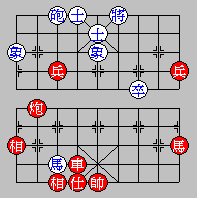OK, it all hinges on how we interpret "escape". Even the formulation above points out that this has to be interpreted in a wide sense: it does not mean you actually have to move the chased piece to a safer location (1). It explicitly states that you can "resolve" the chase with another piece. In the detail examples many cases are given where this is done by interposing a piece (2), or withdrawing the piece that acted as Cannon mount for the attack (3). But there are other conceivable ways to "resolve" an attack by moving another piece than the one that was chased:phhnguyen wrote: 1) What is a chase?
Let me quote from AFX rules:
"Perpetual chase: Player A makes a succession of chasing moves, while player B answers each move by moving away the piece under attack, or resolving the chase with another piece. If A continues to attack the piece move after move, he is making a "perpetual chase"."
- So as I understand in a chase one piece should be attacked and then escape from that attacking. The second action is "escape" but not "become protected".
4) Pinning the attacker, so that he cannot make the capture anymore without exposing his King to check.
5) Deliver a counter check, so that the opponent cannot make the capture, bust must resolve the check first.
None of the detail examples use either of these methods. Of course the classical ways to resolve a threat also encompass capturing the attacker (which is not possible in a repeat loop, and therefore of no concern here), and
6) Protecting the attacked piece.
Now the Asia-rule detail examples, contain the following (unnumbered) diagram as an "appendix":
This explicitly mentions (6) as a recognized method for resolving a chase. Unfortunately it also mentions subverting the protection of a piece as a method to convert a pre-existing attack on that piece to a chase, which contradics several of the other detail examples. So I am not quite sure how to treat this example without wrecking other examples, and WinBoard currently treats this wrong, and would call it a draw.
Appendix: Example of Perpetual Chase
P76 m1+3
P67 m3-1
P78 m5+3
P87 m3-5
P76 ....
Explanation:
Red keeps moving its Pawn to keep the Black Knight "unprotected". This constitutes the Red Rook perpetually chasing the unprotected Black Knight. Red is violating the rule.
Fortunately protecting a piece to resolve a chase almost never occurs in a _perpetual_ chase, becuase it tends to be a method to permanently make the victim invulnarable to chasing. To be able to chase that same piece on the next move, that next move would indeed need to subvert the protection (by blocking or pinning the protector, or moving away its mount).
This is a good point, that might expose a flaw in my current WinBoard implementation of the chase test. I have defined a perpetual chase as an uninterrupted sequence of _new_ attacks on the same piece. I implicitly assumed that when the chased side would not resolve the attack, it would not be possible to make a _new_ attack on the next move, because the attack was already pre-existing. But I overlooked that it might be possible to create a new attack on the same victim with _another_ piece.phhnguyen wrote:- The move Kf0 actually is an action to sacrifice the Advisor Ae1. By that action, White does not move away nor protect that piece
And this is exactly what happens here. Ce5 chases Ae1, and Kf0 does not resolve that attack. But then on the next move, Cf5+ does create an attack by the Horse on this Advisor, by resolving the pinning of it.
So it seems that for any capture by side A that exists after a move of side A, I must not only test if the capture already existed before that move, but also if it still exists after the reply move. (How awkward. Of course I would then have to test in most cases if the victim was protected before the move and after the reply as well, when the attack still existed.)
The case at hand would then fail to be a chase, because the threat Ce5xe1 is not resolved by Kf0: the capture remains possible, and the Advisor is still unprotected.


